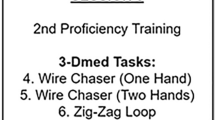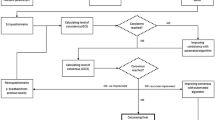Abstract
Objects
This study evaluates the influence of visual-spatial perception on laparoscopic performance of novices with a virtual reality simulator (LapSim®).
Materials and methods
Twenty-four novices completed standardized tests of visual-spatial perception (Lameris Toegepaste Natuurwetenschappelijk Onderzoek [TNO] Test® and Stumpf–Fay Cube Perspectives Test®) and laparoscopic skills were assessed objectively, while performing 1-h practice sessions on the LapSim®, comprising of coordination, cutting, and clip application tasks. Outcome variables included time to complete the tasks, economy of motion as well as total error scores, respectively.
Results
The degree of visual-spatial perception correlated significantly with laparoscopic performance on the LapSim® scores. Participants with a high degree of spatial perception (Group A) performed the tasks faster than those (Group B) who had a low degree of spatial perception (p = 0.001). Individuals with a high degree of spatial perception also scored better for economy of motion (p = 0.021), tissue damage (p = 0.009), and total error (p = 0.007).
Conclusion
Among novices, visual-spatial perception is associated with manual skills performed on a virtual reality simulator. This result may be important for educators to develop adequate training programs that can be individually adapted.



Similar content being viewed by others

References
Bowers CA, Milham LM, Price C (1998) Dual-task results and the lateralization of spatial orientation: artifact of test selection? J Gen Psych 125(1):5–16
Eriksen JR, Grantcharov T (2005) Objective assessment of laparoscopic skills using a virtual reality stimulator. Surg Endosc 19(9):1216–1219
Gallagher AG, McClure N, McGuigan J, Ritchie K, Sheehy NP (1998) An ergonomic analysis of the fulcrum effect in the acquisition of endoscopic skills. Endoscopy 30(7):617–620
Gallagher AG, Cowie R, Crothers I, Jordan-Black JA, Satava RM (2003) PicSOr: an objective test of perceptual skill that predicts laparoscopic technical skill in three initial studies of laparoscopic performance. Surg Endosc 17(9):1468–1471
Hassan I, Weyers P, Marchuw K, Dick B, Gerdes B, Rothmund M, Zielke A (2006) Negative strees-coping strategies among novices in surgery correlate with poor virtual laparoscopic performance. BJS 93(12):1551–1556
Jones DB, Brewer JD, Soper NJ (1996) The influence of three-dimensional video systems on laparoscopic task performance. Surg Laparosc Endosc 6(3):191–197
Keehner MM, Tendick F, Meng MV, Anwar HP, Hegarty M, Stoller ML, Duh QY (2004) Spatial ability, experience, and skill in laparoscopic surgery. Am J Surg 188(1):71–75
McClusky DA 3rd, Ritter EM, Lederman AB, Gallagher AG, Smith CD (2005) Correlation between perceptual, visuo-spatial, and psychomotor aptitude to duration of training required to reach performance goals on the MIST-VR surgical simulator. Am Surg 71(1):13–20
Mueller MD, Camartin C, Dreher E, Hanggi W (1999) Three-dimensional laparoscopy. Gadget or progress? A randomized trial on the efficacy of three-dimensional laparoscopy. Surg Endosc 13(5):469–472
Mueller M (2004) Safety lessons taken from the airlines. Br J Surg 91(4):393–394
Pressmar SB, Haase W (2001) Effects on depth perception and pattern recognition in random dot stereograms by changing the matrix dot density. Ophthalmologe 98(10):955–959
Ro CY, Toumpoulis IK, Ashton RC Jr, Jebara T, Schulman C, Todd GJ, Derose JJ Jr, McGinty JJ (2005)The LapSim: a learning environment for both experts and novices. Stud Health Technol Inform 111:414–417
Schauer P, Ikramuddin S, Hamad G, Gourash W (2003) The learning curve for laparoscopic Roux-en-Y gastric bypass is 100 cases. Surg Endosc 17:212–215
Shah J, Buckley D, Frisby J, Darzi A (2003) Depth cue reliance in surgeons and medical students. Surg Endosc 17(9):1472–1474
Taffinder N, McManus I, Jansen J, Russell R, Darzi A (1998) An objective assessment of surgeons psychomotor skills: validation of the MIST-VR laparoscopic simulator. Br J Surg 85(suppl 1):75
Taffinder N, Smith SG, Huber J, Russell RC, Darzi A (1999) The effect of a second-generation 3D endoscope on the laparoscopic precision of novices and experienced surgeons. Surg Endosc 13(11):1087–1092
Tevaearai HT, Mueller XM, von Segesser LK (2000) 3-D vision improves performance in a pelvic trainer. Endoscopy 32(6):464–468
Wanzel KR, Hamstra SJ, Caminiti MF, Anastakis DJ, Grober ED, Reznick RK (2003) Visual-spatial ability correlates with efficiency of hand motion and successful surgical performance. Surgery 134(5):750–757
Author information
Authors and Affiliations
Corresponding author
Rights and permissions
About this article
Cite this article
Hassan, I., Gerdes, B., Koller, M. et al. Spatial perception predicts laparoscopic skills on virtual reality laparoscopy simulator. Childs Nerv Syst 23, 685–689 (2007). https://doi.org/10.1007/s00381-007-0330-9
Received:
Published:
Issue Date:
DOI: https://doi.org/10.1007/s00381-007-0330-9



